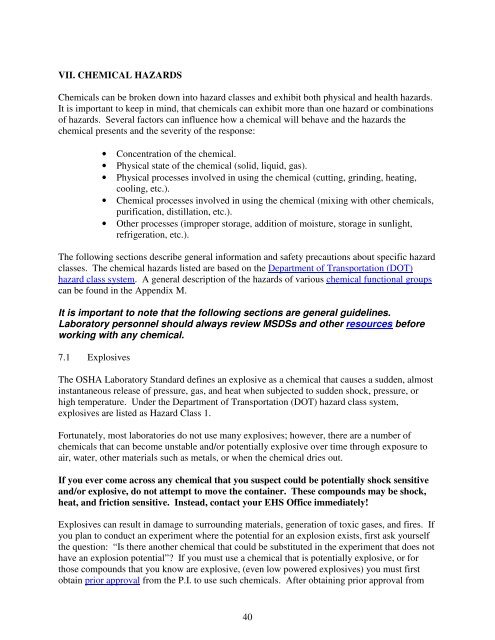Chemical Hygiene Plan - Queensborough Community College ...
Chemical Hygiene Plan - Queensborough Community College ...
Chemical Hygiene Plan - Queensborough Community College ...
Create successful ePaper yourself
Turn your PDF publications into a flip-book with our unique Google optimized e-Paper software.
VII. CHEMICAL HAZARDS<br />
<strong>Chemical</strong>s can be broken down into hazard classes and exhibit both physical and health hazards.<br />
It is important to keep in mind, that chemicals can exhibit more than one hazard or combinations<br />
of hazards. Several factors can influence how a chemical will behave and the hazards the<br />
chemical presents and the severity of the response:<br />
• Concentration of the chemical.<br />
• Physical state of the chemical (solid, liquid, gas).<br />
• Physical processes involved in using the chemical (cutting, grinding, heating,<br />
cooling, etc.).<br />
• <strong>Chemical</strong> processes involved in using the chemical (mixing with other chemicals,<br />
purification, distillation, etc.).<br />
• Other processes (improper storage, addition of moisture, storage in sunlight,<br />
refrigeration, etc.).<br />
The following sections describe general information and safety precautions about specific hazard<br />
classes. The chemical hazards listed are based on the Department of Transportation (DOT)<br />
hazard class system. A general description of the hazards of various chemical functional groups<br />
can be found in the Appendix M.<br />
It is important to note that the following sections are general guidelines.<br />
Laboratory personnel should always review MSDSs and other resources before<br />
working with any chemical.<br />
7.1 Explosives<br />
The OSHA Laboratory Standard defines an explosive as a chemical that causes a sudden, almost<br />
instantaneous release of pressure, gas, and heat when subjected to sudden shock, pressure, or<br />
high temperature. Under the Department of Transportation (DOT) hazard class system,<br />
explosives are listed as Hazard Class 1.<br />
Fortunately, most laboratories do not use many explosives; however, there are a number of<br />
chemicals that can become unstable and/or potentially explosive over time through exposure to<br />
air, water, other materials such as metals, or when the chemical dries out.<br />
If you ever come across any chemical that you suspect could be potentially shock sensitive<br />
and/or explosive, do not attempt to move the container. These compounds may be shock,<br />
heat, and friction sensitive. Instead, contact your EHS Office immediately!<br />
Explosives can result in damage to surrounding materials, generation of toxic gases, and fires. If<br />
you plan to conduct an experiment where the potential for an explosion exists, first ask yourself<br />
the question: “Is there another chemical that could be substituted in the experiment that does not<br />
have an explosion potential”? If you must use a chemical that is potentially explosive, or for<br />
those compounds that you know are explosive, (even low powered explosives) you must first<br />
obtain prior approval from the P.I. to use such chemicals. After obtaining prior approval from<br />
40
















